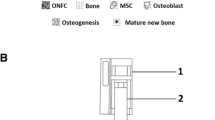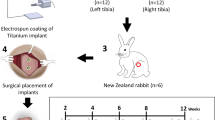Abstract
The objective of this study was to improve the biomechanical performance of titanium (Ti) using a biocompatible electrospun nanofiber matrix. The study is based on the hypothesis that coating a Ti surface with a nanofiber matrix (NFM) made of collagen (CG) and polycaprolactone (PCL) electrospun nanofibers could increase the mechanical fixation of Ti/bone by improving the surface and cytocompatibility properties of Ti. This study prepared Ti samples with and without CG-PCL NFM coatings. This study determined the in vitro effects of each group of Ti samples on the surface topography and cytocompatibility (osteoblast cell adhesion, proliferation, mineralization and protein adsorption) properties. This study also determined in vivo interface shear strength and bone volume fraction of each group of Ti samples with bone using a rabbit model. This study found that the CG-PCL NFM coating on Ti improved the surface roughness, osteoblast cell adhesion, proliferation, mineralization and protein adsorption properties of Ti. In vivo studies found that interface shear strength of CG-PCL NFM-coated Ti/bone samples was significantly higher compared to those values of control Ti/bone samples (p value < 0.05) due to an increase in the amount of growth of the connective tissue joining the Ti implant. Therefore, the developed CG-PCL NFM coating technique should further be investigated for its potential in clinical applications.












Similar content being viewed by others
References
Wu, S., Liu, X., Yeung, K. W. K., Guo, H., Li, P., Hu, T., et al. (2013). Surface nano-architectures and their effects on the mechanical properties and corrosion behavior of Ti-based orthopedic implants. Surface & Coatings Technology, 233, 13–26. doi:10.1016/j.surfcoat.2012.10.023.
Moffat, K. L., Wang, I. N., Rodeo, S. A., & Lu, H. H. (2009). Orthopedic interface tissue engineering for the biological fixation of soft tissue grafts. Clinics in Sports Medicine, 28(1), 157–176.
Pizzo, A., Kokini, K., Vaughn, L., Waisner, B., & Voytik-Harbin, S. (2005). Extracellular matrix (ECM) microstructural composition regulates local cell-ECM biomechanics and fundamental fibroblast behavior: a multidimensional perspective. Journal of Applied Physiology, 98(5), 1909–1921.
Wang, H. B., Mullins, M. E., Cregg, J. M., Hurtado, A., Oudega, M., Trombley, M. T., et al. (2009). Creation of highly aligned electrospun poly-L-lactic acid fibers for nerve regeneration applications. Journal of Neural Engineering, 6(1), 016001.
Keun Kwon, I., Kidoaki, S., & Matsuda, T. (2005). Electrospun nano- to microfiber fabrics made of biodegradable copolyesters: Structural characteristics, mechanical properties and cell adhesion potential. Biomaterials, 26(18), 3929–3939. doi:10.1016/j.biomaterials.2004.10.007.
Po-Yee Lui, P., Zhang, P., Chan, K.-M., & Qin, L. (2010). Biology and augmentation of tendon-bone insertion repair. Journal of Orthopaedic Research Surgery and Research, 5, 59.
Kwon, I. K., Kidoaki, S., & Matsuda, T. (2005). Electrospun nano- to microfiber fabrics made of biodegradable copolyesters: Structural characteristics, mechanical properties and cell adhesion potential. Biomaterials, 26(18), 3929–3939. doi:10.1016/j.biomaterials.2004.10.007.
Kim, G. H. (2008). Electrospun PCL nanofibers with anisotropic mechanical properties as a biomedical scaffold. Biomedical Materials, 3(2), 025010. doi:10.1088/1748-6041/3/2/025010.
Khandaker, M., & Riahinezhad, S. (2016. US patent application no. 62312041.). Method and apparatus to coat a metal implant with an extracellular matrix made with electrospun fiber.
Collagen Protein (2016). Retrieved September 7, 2016.
Wu, G., Bazer, F. W., Burghardt, R. C., Johnson, G. A., Kim, S. W., Knabe, D. A., et al. (2011). Proline and hydroxyproline metabolism: Implications for animal and human nutrition. Amino Acids, 40(4), 1053–1063. doi:10.1007/s00726-010-0715-z.
Stadlinger, B., Pilling, E., Mai, R., Bierbaum, S., Berhardt, R., Scharnweber, D., et al. (2008). Effect of biological implant surface coatings on bone formation, applying collagen, proteoglycans, glycosaminoglycans and growth factors. Journal of Materials Science, 19(3), 1043–1049. doi:10.1007/s10856-007-3077-7.
Kanungo, I., Fathima, N. N., Rao, J. R., & Nair, B. U. (2013). Influence of PCL on the material properties of collagen based biocomposites and in vitro evaluation of drug release. Materials Science and Engineering C, 33(8), 4651–4659. doi:10.1016/j.msec.2013.07.020.
Sultana, F., Vaughan, M. B., & Khandaker, M. (2017). Effect of fiber architecture on the cell functions of electrospun fiber membranes. Mechanics of Biological Systems and Materials, 6, 157–160. doi:10.1007/978-3-319-41351-8_22.
Lu, H., Subramony, S., Boushell, M., & Zhang, X. (2010). Tissue engineering strategies for the regeneration of orthopedic interfaces. Annals of Biomedical Engineering, 38(6), 2142–2154. doi:10.1007/s10439-010-0046-y.
Okuno, O. (1989). Application of beta titanium alloys in dentistry. Dentistry in Japan, 26(1989), 101–104.
Khandaker, M., Riahinezhad, S., Sultana, F., Vaughan, M., Knight, J., & Morris, T. (2016). Peen treatment on a titanium implant: effect of roughness, osteoblast cell functions, and bonding with bone cement. International Journal of Nanomedicine, 11, 585.
Khandaker, M., Riahinezhad, S., Li, Y., Vaughan, M., Sultana, F., Morris, T., et al. (2016). Plasma nitriding of titanium alloy: Effect of roughness, hardness, biocompatibility, and bonding with bone cement. Bio-Medical Materials and Engineering, 27, 461–474.
Peter, B., Gauthier, O., Laib, S., Bujoli, B., Guicheux, J., Janvier, P., et al. (2006). Local delivery of bisphosphonate from coated orthopedic implants increases implants mechanical stability in osteoporotic rats. Journal of Biomedical Materials Research Part A, 76(1), 133–143. doi:10.1002/jbm.a.30456.
Khandaker, M., Utsaha, K. C., & Morris, T. (2014). Interfacial fracture toughness of titanium-cement interfaces: Effects of fibers and loading angles. International Journal of Nanomedicine, 9(1), 1689.
Bhehler. (2012). Application guide polishing: Solutions for materials preparation, testing and analysis.
Whiteside, P., Matykina, E., Gough, J. E., Skeldon, P., & Thompson, G. E. (2010). In vitro evaluation of cell proliferation and collagen synthesis on titanium following plasma electrolytic oxidation. Journal of Biomedical Materials Research Part A, 94(1), 38–46. doi:10.1002/jbm.a.32664.
Click-iT® EdU Imaging Kits. (2011). https://tools.thermofisher.com/content/sfs/manuals/mp10338.pdf.
Currey, J. D. (2002). Bones: Structure and mechanics. Princeton: Princeton University Press.
Clark, R. A., Nielsen, L. D., Welch, M. P., & McPherson, J. M. (1995). Collagen matrices attenuate the collagen-synthetic response of cultured fibroblasts to TGF-beta. Journal of Cell Science, 108(Pt 3), 1251–1261.
Alford, A. I., Kozloff, K. M., & Hankenson, K. D. (2015). Extracellular matrix networks in bone remodeling. International Journal of Biochemistry & Cell Biology, 65, 20–31. doi:10.1016/j.biocel.2015.05.008.
Martínez, E., Engel, E., Planell, J. A., & Samitier, J. (2009). Effects of artificial micro- and nano-structured surfaces on cell behaviour. Annals of Anatomy-Anatomischer Anzeiger, 191(1), 126–135. doi:10.1016/j.aanat.2008.05.006.
Matyas, J. R., Anton, M. G., Shrive, N. G., & Frank, C. B. (1995). Stress governs tissue phenotype at the femoral insertion of the rabbit MCL. Journal of Biomechanics, 28(2), 147–157. doi:10.1016/0021-9290(94)00058-c.
Kropp, B. P., Zhang, Y., Tomasek, J. J., Cowan, R., Furness Iii, P. D., Vaughan, M. B., et al. (1999). Characterization of cultured bladder smooth muscle cells: Assessment of in vitro contractility. The Journal of Urology, 162(5), 1779–1784. doi:10.1016/s0022-5347(05)68237-7.
Jinno, T., Goldberg, V. M., Davy, D., & Stevenson, S. (1998). Osseointegration of surface-blasted implants made of titanium alloy and cobalt-chromium alloy in a rabbit intramedullary model. Journal of Biomedical Materials Research, 42(1), 20–29. doi:10.1002/(SICI)1097-4636(199810)42:1<20:AID-JBM4>3.0.CO;2-Q.
Albu, M. G., Titorencu, I., & Ghica, M. V. (2011). Collagen-based drug delivery systems for tissue engineering, biomaterials. In R. Pignatello (Ed.), Applications for Nanomedicine. InTech: Rijeka.
Zhang, Y. Z., Venugopal, J., Huang, Z. M., Lim, C. T., & Ramakrishna, S. (2005). Characterization of the surface biocompatibility of the electrospun PCL-Collagen nanofibers using fibroblasts. Biomacromolecules, 6(5), 2583–2589. doi:10.1021/bm050314k.
Zankovych, S., Diefenbeck, M., Bossert, J., Mückley, T., Schrader, C., Schmidt, J., et al. (2013). The effect of polyelectrolyte multilayer coated titanium alloy surfaces on implant anchorage in rats. Acta Biomaterialia, 9(1), 4926–4934. doi:10.1016/j.actbio.2012.08.013.
Khandaker, M., Cody, J., Sultana, F., Barnes, M., Odejimi, T., & Vaughan, M. Evaluation of osseointegration of titanium and bone scaffold interfaces. In 2015 SEM Annual Conference & Exposition on Experimental and Applied Mechanics, Costa Mesa, CA USA, 2015. New York: Springer.
Anders, A. (1997). Metal plasma immersion ion implantation and deposition: A review. Surface & Coatings Technology, 93, 158–167.
Acknowledgements
This publication was made possible by Grant Number 5P20GM103447 from the NIH and on-campus faculty Grant and CURE-STEM awards from the College of Math and Science and the University of Central Oklahoma Office of Research and Grants. The AON-1 osteonectin antibody developed by John D. Termine was obtained from the Developmental Studies Hybridoma Bank, created by the NICHD of the NIH and maintained at The University of Iowa, Department of Biology, Iowa City, IA 52242. Special acknowledgment to Andria Hedrick, Research Imaging Facility at the College of Pharmacy in the University of Oklahoma Health Science Center, for µCT analysis support.
Author information
Authors and Affiliations
Corresponding author
Ethics declarations
Conflict of interest
The authors have no conflict of interest.
Rights and permissions
About this article
Cite this article
Khandaker, M., Riahinezhad, S., Sultana, F. et al. Effect of Collagen-Polycaprolactone Nanofibers Matrix Coating on the In Vitro Cytocompatibility and In Vivo Bone Responses of Titanium. J. Med. Biol. Eng. 38, 197–210 (2018). https://doi.org/10.1007/s40846-017-0312-7
Received:
Accepted:
Published:
Issue Date:
DOI: https://doi.org/10.1007/s40846-017-0312-7




